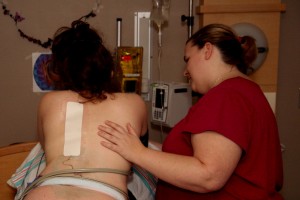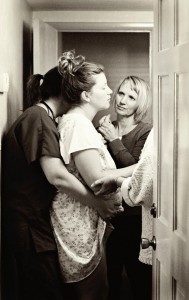May 14, 2014
Evidence Supports Celebrating the Doula! Happy International Doula Month!
By: Sharon Muza, BS, LCCE, FACCE, CD/BDT(DONA), CLE | 0 Comments
May is International Doula Month and I am delighted to recognize and celebrate this important member of the birth team today on Science & Sensibility. A birth doula is a trained person (both men and women can be and are doulas) who supports a birthing person and their family during labor and birth with information, physical and emotional support and assistance in women finding their voice and making choices for their maternity care. A postpartum doula is a trained professional who supports the family during the "fourth trimester" with emotional support, breastfeeding assistance, newborn care and information along with light household tasks as postpartum families make adjustments to caring for a newborn in the house. Birthing families traditionally have received support from family and community going back hundreds of generations. In the early to mid 20th century, as birthed moved from home to hospital, the birthing woman was removed from her support. In 1989, the first doula organization, PALS Doulas was established in Seattle, WA, and then in 1992, DONA International was founded by by leaders in the childbirth and maternal infant health field. Since then, many other training and professional doula organizations have been created around the world and the number of doulas trained and available to serve birthing and postpartum families has grown substantially.

© J. Wasikowski, provided by Birthtastic
Doulas and childbirth educators have similar goals and objectives - to help birthing families to feel supported, informed , strong and ready to push for the best care for themselves and their babies. Some childbirth educators have trained as doulas as well, and may work in both capacities. It can be a wonderful partnership of mutual trust and collaboration. In fact, Lamaze International, the premier childbirth education organization and DONA International, the gold standard of doula organizations have joined together to offer a confluence (conference) jointly hosted by both organizations in Kansas City, MO in September, 2014. An exciting time for networking, continuing education, learning and fun with members of both organizations.
While the profession has grown considerably since those early days, the most recent Listening to Mothers III survey published in 2013, indicates that only 6 percent of birthing families had a trained labor support person/doula in attendance at their birth. (Declercq, 2013) The most recent systematic review on the impact of doulas on a woman's birth experience found that birthing women supported by a doula were:
- more likely to have spontaneous vaginal births
- less likely to have intrapartum analgesia or regional analgesia
- less likely to report dissatisfaction
- more likely to have shorter labors
- less likely to have a cesarean
- less likely to have an instrumental vaginal birth
- less likely to have a baby with a low five minute Apgar score
There were no adverse effects reported. (Hodnett, 2013)
When the American College of Obstetricians and Gynecologists (ACOG) and the Society for Maternal- Fetal Medicine (SMFM) released their groundbreaking "Safe Prevention of the Primary Cesarean Delivery" Obstetric Care Consensus Statement in February 2014, one of their key recommendations to reduce the primary cesarean rate in the USA was the continuous presence of a doula at a birth. (Caughey, 2014)
Continuous Labor and Delivery Support
Published data indicate that one of the most effective tools to improve labor and delivery outcomes is the continuous presence of support personnel, such as a doula. A Cochrane meta-analysis of 12 trials and more than 15,000 women demonstrated that the presence of continuous one-on-one support during labor and delivery was associated with improved patient satisfaction and a statistically significant reduction in the rate of cesarean delivery. Given that there are no associated measurable harms, this resource is probably underutilized. - ACOG/SMFM

© Dianne Hamre by Kristen Self Photography
Doulas do a great job of supporting mothers, partners and families during the childbearing year and helping to improve outcomes for mothers and babies. The research shows it, the experiences of families confirms it and now ACOG recognizes the important role that a trained doula has in reducing the cesarean rate in the United States. Childbirth educators can share this with students and maybe the next time birthing families are surveyed, the number of families choosing to birth with a doula with have risen significantly!
Doulas, thank you for all you do to support families! You are providing a much needed service and improving the birth experience for families around the world. We salute you!
How do you discuss doulas with the families you teach and work with? Do any educators have doulas come in to help during class time? Please share your experiences and let us know how it works out for you and your students and clients.
References
Caughey, A. B., Cahill, A. G., Guise, J. M., & Rouse, D. J. (2014). Safe prevention of the primary cesarean delivery. American journal of obstetrics and gynecology, 210(3), 179-193.
Declercq, E. R., Sakala, C., Corry, M. P., Applebaum, S., & Herrlich, A. (2013). Listening to Mothers III: Pregnancy and Birth; Report of the Third National US Survey of Women's Childbearing Experiences. New York, NY: Childbirth Connection.
Dekker, Rebecca. "The Evidence for Doulas." Evidence Based Birth. N.p., 27 Mar. 2013. Web. 14 May 2-14.
Hodnett ED, Gates S, Hofmeyr GJ, Sakala C. Continuous support for women during childbirth. Cochrane Database of Systematic Reviews 2013, Issue 7. Art. No.: CD003766. DOI: 10.1002/14651858.CD003766.pub5.
Tags
Childbirth education Push for Your Baby Research Lamaze International International Doula Month Labor/Birth Maternal Infant Care DONA 2014 Confluence Confluence